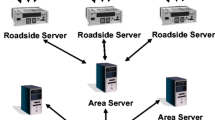Abstract
Recent advancements in sensor, mobile computing, and wireless communication technologies have created an opportunity for mobile computing and online traffic simulations. This paper presents a distributed traffic simulation framework where traffic simulation and data processing are performed in a distributed fashion by mobile computing. In this framework, communication middleware and traffic simulation are integrated to manage the distributed network to synchronize traffic predictions among logical processes using a rollback-based optimistic synchronization protocol. The traffic predictions across the multiple logical processes are coordinated by optimistic execution inspired by Time Warp which mitigates the synchronization problem allowing each logical process to execute asynchronously. Invalidated estimates are updated quickly by this mechanism to ensure more robust and reliable estimates. This framework allows each mobile computing based in-vehicle simulation to model a small portion of the overall network and provide detailed traffic state information. Such a system could provide both more up-to-date and robust predictions than that offered by centralized simulations within a single transportation management center. As these systems evolve, the mobile computing online traffic predictions can be used in surface transportation management and travelers will benefit from more accurate and reliable traffic forecast.







Similar content being viewed by others
References
U.S. Census Bureau (2014) The 2012 Statistical Abstract. http://www.census.gov/compendia/statab Accessed 14 March 2014
Federal Highway Administration (2014) Highway Statistics 2012. http://www.fhwa.dot.gov/policyinformation/statistics/2012/index.cfm Accessed 14 March 2014
Lomax T, Schrank D, Eisele B (2012) 2011 Annual Urban Mobility Report. Institute, Texas Transportation
Suh W (2013) Mobile Computing Traffic Simulation Framework. Proceedings of International Conference on IT Convergence and Security. Macau, China
National ITS Program Plan: A Ten-Year Vision (2014) http://www.channelingreality.com/NAU/ITS/National10YearPlanITSFull_2002.pdf Accessed 14 March 2014
Vehicle Infrastructure Integration Proof of Concept Executive Summary (2014) http://ntl.bts.gov/lib/31000/31000/31078/14481.pdf Accessed 14 March 2014
Suh W (2012) Online Ad Hoc Distributed Traffic Simulation with Optimistic Execution. Dissertation, Georgia Institute of Technology
Suh W (2013) Mobile Computing Traffic Simulation Data Process. Proceedings of International Conference on IT Convergence and Security. Macau, China
Chu L, Recker W (2004) Micro-Simulation Modeling Approach to Applications of On-Line Simulation and Data Fusion. University of California, Berkeley
Wang H, Lee D-H, Cheu R (2004) Dynamic Routing Decisions for Commercial Vehicle Operations in Real-Time Traffic Conditions. Transportation Research Record 1882:201–209
Katwijk R, Koningsbruggen P, Hellendoorn J (2005) A Test Bed for Multi-Agent Control Systems in Road Traffic Management. Applications of Agent Technology in Traffic and Transportation 113–131
Gorgorin C, Gradinescu V, Diaconescu R, Cristea V, Iftode L (2007) Adaptive Traffic Lights using Car-to-Car Communication. Proceedings of IEEE Vehicular Technology. Conference, Dublin
Lee D-H, Chandrasekar P (2005) A Framework for Parallel Traffic Simulation Using Multiple Instancing of a Simulation Program. Intelligent Transportation Systems Journal 7:279–294
Cooperative Vehicle-Infrastructure Systems (2014) http://www.cvisproject.org/ Accessed 14 March 2014
Network on Wheels (2014) https://dsn.tm.kit.edu/english/projects_now-project.php Accessed 14 March 2014
CAR 2 CAR Communication Consortium (2014) http://www.car-to-car.org/ Accessed 14 March 2014
Global System for Telematics (2014) http://www.ertico.com/gst-website Accessed 14 March 2014
Oyama S (2005) DSRC and Ad-hoc Network Development in Japan. Proceedings of the Second ACM International Workshop on Vehicular Ad Hoc Networks (VANET 2005), Cologne, Germany
Connected Vehicle Technology (2014) http://www.its.dot.gov/connected_vehicle/connected_vehicle.htm Accessed 14 March 2014
Jefferson D (1985) Virtual time. Proceedings of ACM Transactions on Programming Languages and Systems 7(3)
PTV (2012) VISSIM User's Manual. Karlsruhe, PTV AG
Fujimoto R (1999) Parallel and Distributed Simulation. Proceedings of the 1999 Winter Simulation Conference. Phoenix, Arizona
Acknowledgments
This work was supported by the research fund of Hanyang University (HY-2013-2247). The author would like to acknowledge Dr. Richard Fujimoto and Dr. Michael Hunter.
Author information
Authors and Affiliations
Corresponding author
Rights and permissions
About this article
Cite this article
Suh, W. Mobile computing traffic simulation framework. Multimed Tools Appl 74, 6169–6181 (2015). https://doi.org/10.1007/s11042-014-2099-7
Received:
Accepted:
Published:
Issue Date:
DOI: https://doi.org/10.1007/s11042-014-2099-7




